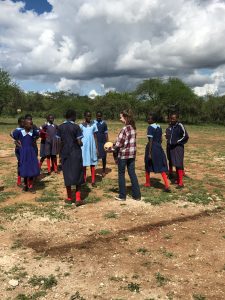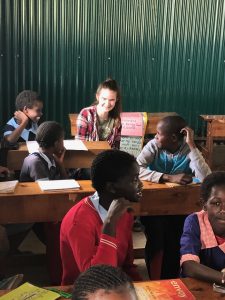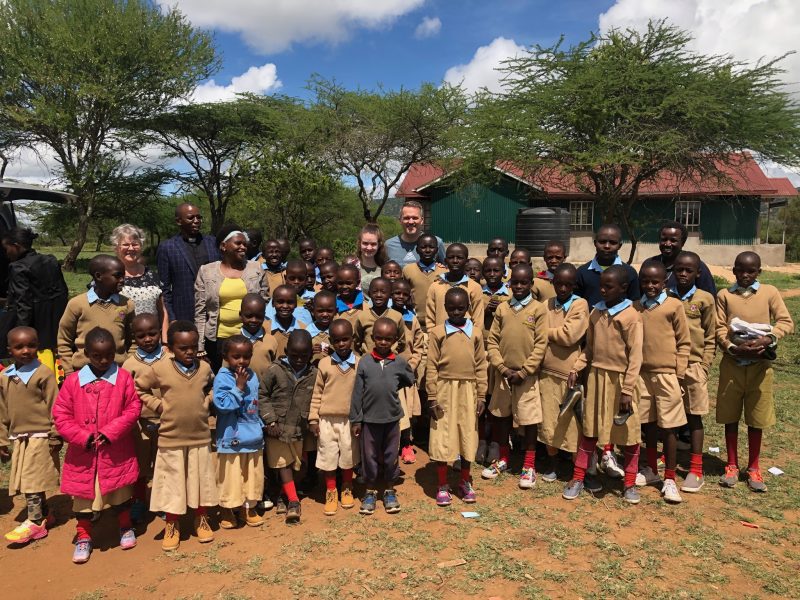Note from Mark Timm, CEO Ziglar Family: This is the fourth and final post in my series about my trip with my daughter, Grace, to provide shoes to orphaned children in Nairobi, Kenya. Please make sure you’ve started at the beginning with Post 1, Post 2, and Post 3!
After our early morning on the streets of Nairobi, we still had two more orphanages to visit. I’m not going to lie—I was concerned about whether we had enough shoes, at least enough of the right size of shoes, for all of the children we were still going to meet.
Our next stop was quite a distance away. Along the way we stopped and picked up Reverend Robert who was with the Presbyterian Church of Kenya. He’s head of all the ministries of that region, and he teaches at Columbia University in the US during January and February of each year. Then the rest of the time he’s in Kenya, teaching at a Catholic college and fulfilling his ministerial duties.
A short while later, we picked up another person who is over the girls’ and boys’ schools of that region, Laurie, an American from South Carolina.
Our entire group now assembled, we finally ended up at one of the boys’ schools. There were 26 boys, and they had one building with three classrooms and a dormitory room, where they all sleep double bunk. So these boys sleep in there; they go to school in there; they do chores, etc. These were younger children, though, and Grace just really connected with them.
Well, even though we were nervous about whether these kids would have shoes, every single kid got a pair of shoes and all the teachers got a pair of shoes! I mean, it seemed like these shoes were just like the multiplying bread and fish that Jesus provided to the 5,000! We think we’re just about out, and then we go to the next orphanage, and somehow enough shoes that appear!
But seriously, we had gone to four orphanages, and not one single kid was left without a pair of shoes, not one teacher was left without a pair of shoes, and not not one helper was left without a pair of shoes. We got to literally put the shoes on every single child’s feet, and they bounced when they were done and started singing, If you’re happy and you know it, clap your hands!
Take a listen…
That was like the crescendo of our time there, hearing songs that we just think of as our American kind of songs, but discovering they connect us across the world.
We went from there over to the girls’ school by way of a “bush path,” which means that we were basically on a rock and dirt path for the short trip. The girls school was actually very humbling, because the whole reason for its existence is to protect girls in the Masai region, who at the age of 8 or 9 years old, are frequently sold to men in exchange for cows.

In their culture, there the man is ranked highest, and then cows, and then women. In fact, women are just really considered livestock to the men because they are owned by the men, and the men can sell them. Additionally, they practice polygamy, so one man can have five wives if he wants. That’s why a poor nine-year-old girl can be sold to a 40-year-old man.
And she doesn’t even know it until the man shows up with the cows. The next thing she knows, she’s leaving with that man, and there is nothing she can say or do about it. So essentially, boys are just cheap, free labor, and the girls are, as they say, income-producing livestock because she will be sold someday. Therefore, she has value.
So this whole school was created to save these girls. In fact, there was a group of 26 girls who were all getting to be the age of being sold. So their mothers took these girls and hid them in the church. As a result of that, the men rounded up the moms and actually beat them, shouting, “Where are the girls? Where are the girls?”
So the church people knew they had to do something; they couldn’t let those girls go back. They knew what their future was going to be. So they literally started the school with those 26 girls. All 26 lived in one room. They went to class in that room. They slept in that room. They ate in that room. And that was the beginning of the girls’ school.
And now, just a few years later, that school has over 150 girls. In fact, they added 60 girls in just the first four months of 2019, because the word is out that if you can get your girls to that school, then they’re safe. In fact, they’re educating the community on why it’s wrong to marry off someone at nine years old or to sell your child! As parents are starting to realize, and as fathers are realizing what they did was wrong, they want to see their daughters. They actually have to sign a contract that’s been prepared, a legal contract, if they are to visit their family for Christmas or holiday, that the father cannot sell them.
It’s pretty unbelievable that this whole idea of selling your child exists, but it does, and the school was making a difference, making an impact on what would be an awful tragedy in these girls’ lives.

At that school, the last of our trip, we ran out of time, and we still had all of the remaining shoes. So we decided we would give the teachers all that we had left so that they could find the appropriate shoe for each girl.
In the end, well over 500 kids—and many adults—in Kenya had shoes on their feet after we left. Mission accomplished.
I think for me, as a dad, the part that I will never forget is just seeing Grace, seeing the joy on Grace’s face, seeing the way she loves humanity, the way she loves people, the way she loves kids, seeing how passionate she was about everything she did and how she lit up with these kids.
It wouldn’t surprise me if she becomes a doctor and goes over there, village to village, loving on these kids, treating these kids, helping these kids, because that’s her heart. Her heart is that big. It’s the size of Kenya, and it’s certainly needed over there, that’s for sure.
So with Grace’s Shoes for Change, I know she changed the lives of at least 500 Kenyan kids, but I know she changed her life as well and mine.



Leave A Comment